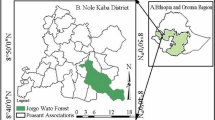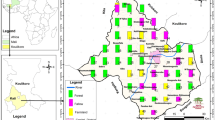Abstract
Non Timber Forest Products play an important role as source of food and income generation in developing countries. In Burkina Faso, many wild tree species provide various useful products, among them the local oil tree, Lophira lanceolata which occurs in the western part of the country. This study aimed at assessing the habitat diversity and population structure of L. lanceolata’s natural stands according to land cover types. Two sites were considered: Banfora, where the use value of fruits is unknown and Orodara, where fruits are exploited for oil production. A stratified and oriented sampling scheme based on the occurrence of L. lanceolata and land cover was applied using rectangular plots of 50 m × 20 m. Phytosociological and quantitative inventories were carried out to assess the woody species diversity of stands and L. lanceolata population structure, respectively. Species diversity indices, structural parameters were computed and analyses of variance, Chi square test were performed to compare sites according to land cover types. The results showed high woody species diversity associated with L. lanceolata stands (H = 3.2–3.6). The densities of L. lanceolata ranged between 94 and 280 trees per hectare, with significant differences between land cover types and sites. The population pattern showed a good regeneration potential and high resource availability. L. lanceolata was fairly resilient to human pressure and tended to recolonize disturbed lands. With a high potential for sustainable management, L. lanceolata is a promising NTFP species which can contribute to improve the local and national economy.





Similar content being viewed by others
References
Ajbilou R, Maranon T, Arroyo J, Ater M (2007) Structure and diversity of the shrubby stratum of peninsula Tingitane’s forest (Moroco). Acta Bot Malacca 32:147–160
Akoègninou A, Van Der Burg WJ, Van Der Maesen LJG (2006) Flore analytique du Bénin. Backhuys Publishers, Cotonou & Wageningen
Arbonnier M (2002) Arbres, arbustes et lianes des zones sèches d’Afrique de l’Ouest. 2e édition, CIRAD, MNHN-UICN, Montpellier
Assogbadjo AE, Glèlè Kakaï R, Sinsin B, Pelz D (2009) Structure of Anogeissus leiocarpa Guill. & Perr. natural stands in relation to anthropogenic pressure within Wari-Maro Forest Reserve in Benin. Afr J Ecol 48:644–653
Atabani AE, Silitonga AS, Ong HC, Mahlia TMI, Masjuki HH, Badruddin IA, Fayaz H (2013) Non-edible vegetable oils: a critical evaluation of oil extraction, fatty acid compositions, biodiesel production, characteristics, engine performance and emissions production. Renew Sust Energ Rev 18:211–245
Avocèvou-Ayisso C, Sinsin B, Adégbidi A, Dossou G, Van Damme P (2009) Sustainable use of non-timber forest products: impact of fruit harvesting on Pentadesma butyracea regeneration and financial analysis of its products trade in Benin. For Ecol Manage 257:1930–1938
Azihou AF, Glèlè Kakaï R, Bellefontaine R, Sinsin B (2013) Distribution of tree species along a gallery forest-savanna gradient: patterns, overlaps and ecological thresholds. J Trop Ecol 29:25–37
Bationo BA, Ouédraogo SJ, Somé AN, Pallo F, Boussim IJ (2005) The natural regeneration of Isoberlinia doka Craib and Stapf in the Nazinon classified forest (Burkina Faso). Cahiers d’études et de recherches francophones 14:297–304
Bazongo P, Bassole IHN, Nielsen S, Dicko MH, Shukla VKS (2014) Studies in the Evaluation of Unconventional Oils from Burkina Faso Rich in Linoleic Acid, Oleic Acid or Other Unusual Fatty Acids. J Food Process Technol 5:303
Bellefontaine R, Edelin C, Ichaou A (2000) Le drageonnage, alternative aux semis et aux plantations de ligneux dans les zones semi-arides. Sécheresse 11:221–226
Bognounou F, Thiombiano A, Savadogo P, Boussim JI, Oden PC, Guinko S (2009) Woody vegetation structure and composition at four sites along a latitudinal gradient in Western Burkina Faso. Bois For Trop 300:30–44
Braun-Blanquet J (1932) Plant sociology. Macgran-Hill, New York and London
Cunningham AB (2001) Applied ethnobotany. People and Plants Conservation Manuals. People, Wild Plant Use and Conservation. Earthscan Publications Ltd, London
D’Agostino RB, Stephens MA (1986) Goodness-of-fit techniques. Marcel Dekker, New York
Djossa BA, Fahr J, Wiegand T, Ayihouenou BE, Kalko EE, Sinsin BA (2008) Land use impact on Vitellaria paradoxa C.F. Gaerten. stand structure and distribution patterns: a comparison of Biosphere Reserve of Pendjari in Atacora district in Benin. Agrofor Syst 72:205–220
FAO (2008) Harmonized world soil database (version 1.0). FAO, Rome, p 37
FAO (2010) Evaluation des ressources forestières mondiales. Etude FAO: forêts 163, rapport principal, Rome
Fariku S, Kidah M (2008) Biomass potential of Lophira lanceolata fruit as a renewable energy resource. Afr J Biotechnol 7:308–310
Feeley JK, Davies SJ, NurSupardi Noor MD, Kassim AR, Tan S (2007) Do current stem size distributions predict future population changes? An empirical test of intraspecific patterns in tropical trees at two spatial scales. J Trop Ecol 23:191–198
Fontes J, Guinko S (1995) Vegetation and’s map of Burkina Faso. Explanatory Note. Ministry of French Cooperation, Campus Project (88 313 101), Toulouse
Kakaï RG, Sinsin B (2009) Structural description of two Isoberlinia dominated vegetation types in the Wari–Maro Forest Reserve (Benin). S Afr J Bot 75:43–51
Gnoumou A, Bognounou F, Hahn K, Thiombiano A (2011) A comparison of Guibourtia copallifera Benn. stands in South West Burkina Faso-community structure and regeneration. J Forest Res 23:29–38
Green RH (1966) Measurement of non-randomness in spatial distributions. Res Pop Ecol 8:1–7
Greig-Smith P (1983) Quantitative plant ecology, 3rd edn. Blackwell Scientific Publications, Oxford
Husch B, Beers TW, Kershaw JA Jr (2003) Forest mensuration, 4th edn. Wiley, London
Jayaraman K (1999) A statistical manual for forestry research. FORSPA-FAO Publications, Bangkok
Johnson NL, Kotz S (1970) Distributions in statistics: continuous univariate distributions, 2nd edn. Wiley, New York
Lohlum SA, Maikidi GH, Salomon M (2010) Proximate composition, amino acid profile and phytochemical screening of Lophira lanceolata seeds. Afri J Food Agr Nutr Dev 10:1–12
Natta AK, Adomou AC, Tchabi VI, Sogbegnon AR, Mensah GA, Sinsin BA (2011) Inventaire, typologie et structure des populations naturelles de Pentadesma butyracea (Clusiaceae) de la chaîne de l’Atacora au Nord-Ouest du Bénin. Bull Recherche Agron Bénin 70:10–24
Obiri J, Lawes M, Mukolwe M (2002) The dynamics and sustainable use of high-value tree species of the coastal Pondoland forest of the Eastern Cape Province South Africa. For Ecol Manag 166:131–148
Okullo JBL, Waithum G (2007) Diversity and conservation of on-farm woody plants by field types in Paromo Subcountry, Nebbi District, North Werstern Uganda. Afr J Ecol 45:59–66
Ouédraogo A, Thiombiano A (2012) Regeneration pattern of four threatened tree species in Sudanian savannas of Burkina Faso. Agrofor Syst 86:35–48
Ouédraogo A, Thiombiano A, Hahn-Hadjali K, Guinko S (2006) Diagnostic de l’état de dégradation des peuplements de quatre espèces ligneuses en zone soudanienne du Burkina Faso. Sécheresse 17:485–491
Ouédraogo A, Lykke AM, Lankoandé B, Korbéogo G (2013a) Potential for promoting oil products identified from traditional knowledge of native trees in Burkina Faso. Ethnobot Res Appl 11:71–83
Ouédraogo A, Glèlè Kakaï R, Thiombiano A (2013b) Population structure of the widespread species, Anogeissus leiocarpa (DC.) Guill. & Perr. across the climatic gradient in West Africa semi-arid area. S Afr J Bot 88:286–295
Ouôba P, Boussim J, Guinko S (2005) Le potentiel fruitier de la forêt classée de Niangoloko au Burkina Faso. Fruits 61:17–81
Ouôba P, Lykke AM, Boussim J, Guinko S (2006) La flore médicinale de la forêt classée de Niangoloko (Burkina Faso). Études sur la flore et la végétation du Burkina Faso et des Pays avoisinants 10:5–16
Peters CM (1997) Exploitation soutenue de produits forestiers autres que le bois en forêt tropicale humide: Manuel d’initiation écologique. Programme d’Appui à la Biodiversité, Washington
Rondeux J (1999) La mesure des arbres et des peuplements forestiers. Les presses agronomiques de Gembloux, 2e édition, Gembloux
Sambaré O, Bognounou F, Wittig R, Thiombiano A (2011) Woody species composition, diversity and structure of riparian forests of four watercourses types in Burkina Faso. J Forest Res 22:145–158
Schmidt M, Kreft H, Thiombiano A, Zizka G (2005) Herbarium collections and field data-based plant diversity maps for Burkina Faso. Divers Distrib 11:509–516
Shackleton S, Delang CO, Angelsen A (2011) From subsistence to safety nets and cash income: exploring the diverse values of non-timber forest products for livelihoods and poverty alleviation. Trop Forest 7:55–82
Sinsin B, Eyog Matg O, Assobgadjo AE, Gaoué OG, Sinadouwirou T (2004) Dendrometric characteristics as indicators of pressure of Afzelia africana Sm. dynamic changes in trees found in different climatic zones of Benin. Biodivers Conserv 13:1555–1570
Sokpon N, Dotonhoué F, Ouinsavi C (2011) Patterns of ecological structure and spatial distribution of kapok tree (Ceiba pentandra) populations in Bénin. Ann Univ Parakou Sér 2:5–26
Tabuti JRS, Mugula BB (2007) The ethnobotany and ecological status of Albizia coriaria Welw. ex Oliv. in Budondo Sub-county, eastern Uganda. Afr J Ecol 45:126–129
Thiombiano A, Schmidt M, Dressler S, Ouédraogo A, Hahn K, Zizka G (2012) Catalogue des plantes vasculaires du Burkina Faso. Boisseria 65:1–391
Traoré L, Ouédraogo I, Ouédraogo A, Thiombiano A (2011) Perceptions, usages et vulnérabilité des ressources végétales ligneuses dans le Sud-Ouest du Burkina Faso. Int J Biol Chem Sci 5:258–278
Van der Vossen HAM, Mkamilo GS (2007) Plant resources of tropical Africa 14. Vegetable oils. PROTA Foundation, Wageningen
Venter SM, Witkowski ETF (2010) Baobab (Adansonia digitata L.) density, size-class distribution and population trends between four land-use types in northern Venda, South Africa. For Ecol Manag 259:294–300
Wild RG, Mutebi J (1996) L’utilisation des ressources végétales par les communautés, un moyen de conservation. Peuples et Plantes 5:1–49
Yadav M, Dugaya D (2013) Non-timber forest products certification in India: opportunities and challenges. Environ Dev Sustain 15:567–586
Acknowledgments
This work was funded by Danida (10-002AU) through the QualiTree research project, to which the authors are grateful. The authors are also grateful to Hubert Coulibaly, our field assistant and to the local population from the two study sites (Banfora and Orodara) for their great collaboration.
Author information
Authors and Affiliations
Corresponding author
Rights and permissions
About this article
Cite this article
Lankoandé, B., Ouédraogo, A., Boussim, J.I. et al. Natural stands diversity and population structure of Lophira lanceolata Tiegh. ex Keay, a local oil tree species in Burkina Faso, West Africa. Agroforest Syst 91, 85–96 (2017). https://doi.org/10.1007/s10457-016-9913-3
Received:
Accepted:
Published:
Issue Date:
DOI: https://doi.org/10.1007/s10457-016-9913-3




